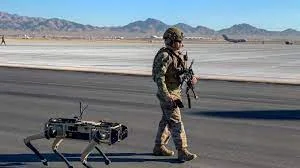"Ghost Robotics" robotic dogs take their positions to protect the US border
The US Department of Homeland Security released new details this week about experiments with four-legged robots on the southern border with Mexico.
Robot dogs are tested in a variety of roles focused on observation. Although the Department of Homeland Security has not shared any full-term deployment timeline, it says the trials have been "successful" and that work with the robotic dogs will continue.
"The southern border can be a no-go for soldiers and live dogs, which is exactly why the machine stands out there," said Brenda Long, program manager for the department's research and development division.
The robotic dogs were built by Ghost Robotics, a competitor to Boston Dynamics.
The most popular robotic dog model, the Ghost Vision 60, is 2.5 feet (76 cm) tall, weighs 70 pounds (32 kg), and can walk more than 7.5 miles (12 km) in 3 hours on a single battery charge. .
The robotic dogs can navigate independently or with manual control, and can be equipped with a number of payloads, including thermal and night vision cameras. In the past, Ghost Robotics has shown prototypes equipped with guns.
In a detailed blog post, the Department of Homeland Security explained how it tested robotic dogs for potential border action.
The robotic dogs have been tested for “guarding” the outdoors, autonomously patrolling previously designated waypoints via GPS while carrying cameras and sensors, inspecting train carriages, navigating around and under wagons, and exploring apartment buildings. Including "a scenario that simulates confronting potentially enemy individuals".
These are all tasks that robot dogs have been tested on before. The main advantage of these four-legged machines is that unlike machines with wheels they can navigate any environment that humans can navigate, including desert or steep hills, rocky terrain and even stairs.
But despite their sophistication, these machines also have obvious limitations. Practical experiments have shown a number of potential issues, such as limited battery life and erratic behaviour.
And when the French army tested the “Boston Dynamics” robot in military exercises, the soldiers complained that the device’s battery had run out too quickly, while the reports of the American police experiments with “Boston Dynamics” robot dogs called “Spot” complained of incomplete performance, with the fall of Sometimes machines "for no apparent reason".
Objection to the use of robots
Politicians and civil rights groups criticize the use of such machines in military actions, especially when using robots to interact with humanitarian cases, in the issue of refugees in particular, especially since the US border forces that participated in these recent experiments are famous for their inhumane behavior towards immigrants.
A 2021 Human Rights Watch investigation detailed 160 internal reports of physical and sexual abuse of asylum seekers at the border in recent years.
The Department of Homeland Security compared the deployment of robot dogs at the border to drones as a "force multiplier" that could complement human resource work.
As attempts to build walls across the US border have stalled, the government has increasingly turned its efforts to technological solutions, and robotic dogs appear to be the latest addition to these efforts.
After 17 years of growth, users force Facebook to stop and re-account
Facebook on Wednesday reported its first quarterly drop in daily users globally since it came out 17 years ago.
In addition, the company achieved less growth in advertisements than expected, which led to a decline in its shares by about 20%.
The massive drop in shares, which instantly wiped out nearly $200 billion of the company's market value, shows that changing the Facebook brand to "Meta" is not enough to distract investors from the problems at its core social media business.
The main Facebook app lost 1 million daily users in North America, where it makes the most money through ads. This drop led to an overall decrease in the number of daily users of Facebook globally, which a company spokesperson confirmed as the first sequential decline in the company's history.
This drop from 1.93 billion in the third quarter to 1.929 billion daily users in the fourth is likely a reflection of young people's lack of engagement with Facebook.
The statistic shows how Meta has struggled to stay relevant with younger users, who are increasingly drawn to competing apps like TikTok. That puts more pressure on Meta's big bet on the future of metaverse, the virtual reality-enabled alternate universe that CEO Mark Zuckenberg sees as the future of the internet.
Still winning
Meta is still profitable despite that drop, having generated nearly $40 billion in revenue in the last year alone, mostly from advertising.
But it's also losing billions in Reality Labs, the division responsible for the Quest VR headset, virtual reality software, upcoming AR goggles, and other related initiatives. Link to metaverse.
Meta also reported lower-than-expected earnings and revenue growth, which it says was driven in part by inflation and Apple's new ad tracking privacy restrictions that limit Meta's ability to sell ads. The company also faces constant scrutiny from government regulators around the world over antitrust concerns and content moderation.
There is now no doubt that Facebook, or META as it is now called, is facing a real challenge to its dominance of social media. The sway of the largest application of social media in this space is no longer taken for granted as it was more than a decade ago.




